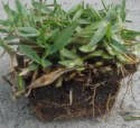Why verticutting
A HEALTHY HABIT
Vertical mowing delivers a bevy of benefits to turfgrass, such as:
1. Clears out thatch and removes excess turf growth
2. Provides channels for water infiltration
3. Opens turf canopy so sunlight and nutrients can settle into soil
4. Promotes new, healthy turf growth
The dominant grass in central and south Florida is St. Augustine
Thatch is defined as an intermingled layer of dead and living shoots, stems, and roots that develops between the zone of green vegetation and the soil surface. Thatch consists of a loosely interwoven collection of plant matter that leaves the turf feeling spongy or puffy .
When excessive (1 inch or more), thatch causes serious problems in Florida lawns. inch or more), thatch causes serious problems in Florida lawns.
Thatch accumulations are undesirable for a variety of reasons.
• Thatch can restrict water and air movement into the soil. Dry thatch tends to repel water rather than allow infiltration, and wet thatch enhances disease problems. If your lawn has dry spots that are difficult to rewet (unless you almost flood the areas), these are probably dry thatch spots.
Thick thatch makes mowing very difficult. As thatch builds up, mowing height actually increases above the soil line, and the turf becomes very spongy, allowing the mower to sink into the turf and scalp the lawn. This results in an uneven appearance and often a mottled brown and green surface.
Thatch provides an ideal habitat for insects and disease. Thatch accumulation is associated with an increased incidence of many insects and diseases.
• A thatchy condition elevates the growing points (crowns), runners (rhizomes and stolons) and roots above the soil surface.
This document is ENH12, one of a series of the Environmental Horticulture Department, Florida Cooperative Extension Service, Institute of Food and Agricultural Sciences, University of Florida
....................................................................................................................................................................................................Recommend two verticutting customers, jobs we complete and receive a free voucher to:
....................................................................................................................................................................................................Recommend two verticutting customers, jobs we complete and receive a free voucher to:
York's School of Landscape Maintenance: http://yorkslms.blogspot.com/ or www.verticutting.com
..................................................................................................................................................
Cutting Up
There is a missing link in many lawn care programs — an underutilized cultural practice that boosts turf health and, potentially, your bottom line. Vertical mowing is a healthy habit and a beneficial component of an annual turf care routine. Simply put, vertical mowing encourages turf to take its vitamins.
The practice turns up thatch and opens the turf canopy so it can drink up nutrients and water, and clear out room for fresh growth. Verticutting is an energy boost, setting the stage for green-up in spring and preparing turf for overseeding in the north. And most turf varieties appreciate verticutting — the vigorous mowing isn't limited to sports turf or commercial properties.
Consider verticutting part of a balanced diet. Here are some ways to make sure your turf receives the correct dose and some details on choosing appropriate equipment to deliver the best results.
A HEALTHY HABIT
Vertical mowing delivers a bevy of benefits to turfgrass, such as:
1. Clears out thatch and removes excess turf growth
2. Provides channels for water infiltration
3. Opens turf canopy so sunlight and nutrients can settle into soil
4. Promotes new, healthy turf growth
Winner of 4 City of St. Petersburg City Beautification Awards
727-455-7337 or whyverticutting.com






